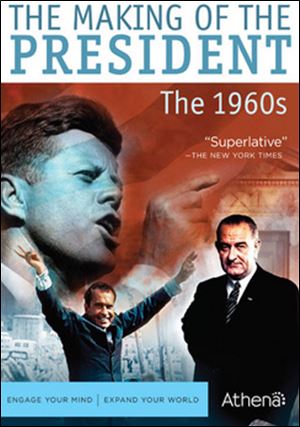
How we picked our Presidents, 1960s style
7/7/2011
'The Making of the President: The 1960s.'
Few students of popular culture, amateur or professional, consider the 1960s a period when creativity flourished on American television. Westerns of the kind that did not threaten to obscure the legacy of John Ford prevailed, speaking to the pastoral fantasies of millions of Americans who had vacated decaying cities for the tempered pleasures of suburban life. The same demographic realities could be held accountable for the absurdist escapism of something like Green Acres. Between 1950 and 1960, the U.S. population swelled by about 28 million; two-thirds of that growth occurred in suburbia. Television had come to occupy a place in 44 million homes.
It would take decades for the medium to reach its golden age as a narrative form, but as television evolved into a crucial system for distributing information it succeeded impressively in the genre of documentary. The early '60s were, in fact, a high point for television documentaries. During the 1961-62 season, CBS, NBC, and ABC cumulatively broadcast more than 250 hours of such programming. The marred reputation of the networks after the quiz show scandals of the 1950s had set them on a course toward regaining credibility. At the same time, Newton Minow's call as the chairman of the Federal Communications Commission for more purposeful television generally encouraged network affiliates to show more of what the growing category offered.
The new atmosphere created a great opportunity for independent producers, among them David L. Wolper, who brought American viewers enduring works like specials from the National Geographic Society and the series Biography (and later, the miniseries Roots). Beginning in 1963, he also delivered a trio of documentaries based on the classic texts of political reporting by the journalist Theodore H. White: The Making of the President, 1960, The Making of the President, 1964, and The Making of the President, 1968. Wolper Productions distilled these exhaustively detailed books into 80-minute films, which have become available on DVD for the first time (from Athena, in a boxed set, The Making of the President: The 1960s).
The films capture the books' broad scope, covering successive presidential campaigns -- John F. Kennedy versus Richard M. Nixon, Lyndon B. Johnson versus Barry M. Goldwater, and Nixon versus Hubert H. Humphrey and George C. Wallace -- in a kind of minute-to-minute chronology from the primary battles through the general elections. The stories are told from the perspective of a shifting social landscape and through the lens of the backroom factionalism that beset both major parties throughout the decade.
The second film provides a compelling look at the culture wars in their infancy as the division between elite Republicans of the Northeast and conservative populists who flocked toward Goldwater began to seem insurmountable. Nelson A. Rockefeller famously sought the presidential nomination that year not long after his marriage had ended and he had wed a divorcee, Margaretta Murphy (known as Happy), whom people had compared to Wallis Simpson. "To men and women of dogmatic morality," the film's narrator intones with a discernable condescension toward the ordinary, "this appears the manners of Manhattan -- Babylon of the East."
A distrust of Ivy League sophistication had by then already fomented. Illuminating this is footage of an a cappella group stumping for Goldwater, singing: "Pity that Harvard poor bunch/Just think about their doom/They'll have to leave the White House and go back to their classroom." Watching the films, you find yourself wondering repeatedly: Whatever happened to the campaign song, or rather, whatever happened to the campaign song not merely appropriated from the Fleetwood Mac catalog?
What the films offer in range, they lack in intimacy. White's initial entry, The Making of the President, 1960, is considered the best in his opus (which included a fourth book on the contest between Nixon and George S. McGovern in 1972). It won the Pulitzer Prize for nonfiction in 1962, and the companion film garnered four Emmys. While the film is the trilogy's most richly told chapter, it cannot accommodate the endless array of novelistic observations for which its source material has been celebrated. White traveled the campaign as a reporter, not as a man with a multimedia agenda.
The Making of the President films must have felt already comparatively old-fashioned when they were shown. White, an odd-looking figure with a stilted speaking manner, is not necessarily a welcome visual presence in them. Still, the films offer a concise education in the intricacies of American politicking in advance of an election year in which our divisions remain so acute.